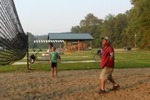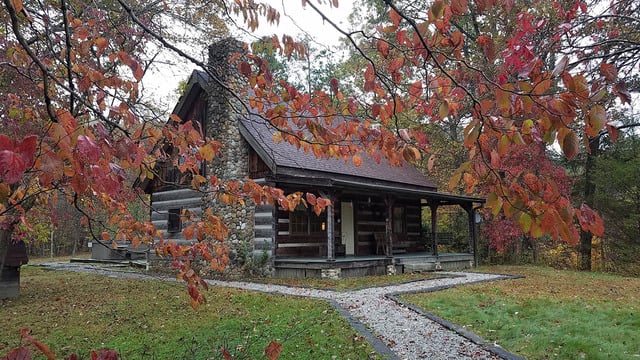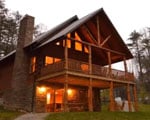SCIOTO TRAIL STATE PARK
A small, quiet park nestled in beautiful 9,000-acre Scioto Trail State Forest, this state park is an undisturbed wooded refuge just south of Chillicothe. The ridgetops and winding forest roads offer breathtaking vistas of the Scioto River Valley. The beauty and remoteness of Scioto Trail offers the best of escapes to park visitors.
Located in the Appalachian foothills bordering the Scioto River, the park's rugged ridgetops and wooded valleys support a host of natural wonders. This densely forested hill country is reminiscent of the southern Appalachians supporting a magnificent stand of oak and hickory. In spring, the forest trails are lined with flowering dogwood and redbud trees. The forest floor displays woodland wildflowers including spring beauties, Dutchman's breeches, wild blue phlox and wild geranium. Ferns, mosses and lichens coat the sandstone outcroppings. Mushroom hunters delight in the abundance of the delicious morel mushroom.
The remoteness of the area and dense forest provides excellent habitat for some of Ohio's most elusive wildlife. Wild turkey populations are thriving in this region along with ruffed grouse and white-tailed deer. Small mammals of Scioto Trail include red fox, skunk, opossum, gray squirrel and raccoon among many others. Rare sightings of bobcat and black bear have been reported. Many reptiles and amphibians find the woodlands and streams of the area desirable.
Scioto Trail State Park is nestled in an area rich with reminders of Ohio's prehistoric peoples. These Mound Builders left extensive earthworks throughout the Scioto River Valley and its tributaries. Serpent Mound, in northeastern Adams County, is a 1,000-foot snake effigy mound built by the Adenas. Other smaller Adena mounds exist in Ross County. The Adena culture is named after the estate of early Ohio statesman Thomas Worthington. Adena, near Chillicothe, was the site of the first mound excavation attributed to these prehistoric people.
Other extensive earthworks exist north of Chillicothe on the Scioto floodplain. Mound City is attributed to a more advanced culture called the Hopewells. Other Hopewell mounds in the Scioto Trail region are Seip Mound, Spruce Hill and Fort Hill. The importance of the Scioto River to the early development of Ohio carried through from these prehistoric peoples to the Shawnee and first pioneer settlers.
The Shawnee utilized the river as their primary means of transportation from one village to another. The Scioto Trail was an Indian trail that followed the Scioto River from northern Ohio to the Kentucky hunting grounds. The trail was later used by settlers who came upriver from Portsmouth to the first capital of Ohio--Chillicothe. There is a replica of the first church in the area, Chillicothe's First Presbyterian, in Caldwell Lake Hollow. This plain log structure gives testimony to the simple lifestyle of early Ohioans.
The first European settlers came to the area in the 1790s. In 1796, General Nathaniel Massie and a small group of settlers started the town of Chillicothe. Many of these first Ohioans were veterans of the Revolutionary War. The land west of the Scioto River and east of the Little Miami River was set aside for Virginia veterans of the Revolution. Land allotments were based on time served and rank of these soldiers.
Initial purchases of land for the park and forest began in 1922. Most of the major development took place in the 1930s during the original Civilian Conservation Corps (CCC) days. They constructed most of the roads, lakes and the original recreational facilities.
Ohio does not have an annual pass and does not charge entrance fees to state parks.
GeneralLand, acres218
Water, acres30
Nearby State Forest, acres9,151
Day-UseFishingyes
Huntingyes
Hiking Trail, miles5
Backpack Trailyes
Picnickingyes
Bridle Trailsyes
BoatingBoating Limits-1
Launch Ramps, #1
CampingPrimitive, #33
Electric Sites, #40
Pets Permittedyes
Dumpstationyes
Camper Cabins, #2
WinterSleddingyes
Cross-Country Skiingyes
Ice Skatingyes
Ice Fishingyes
The wooded campground at Caldwell Lake offers 56 sites of which 40 are equipped with electricity. Pit latrines, dump stations, fire rings and picnic tables are provided. A primitive walk-in camp located near Stewart Lake offers an additional 18 non-electric sites.

Cottages and Cabins
Rustic beauty in a peaceful, clean atmosphere is the secret to this Family Retreat. The serene splendor of Mother Nature is your reward for visiting Walnut Creek. We offer cabin rentals for those who want the convenience with less effort.
5.8 miles from park*
Two small lakes offer boating with electric motors only. Canoeing is excellent on these quiet waters. A launch ramp is provided.
Scioto Trail State Park in Ohio offers a variety of fishing options for both experienced and novice anglers. The park is home to two beautiful lakes, Caldwell Lake and Stewart Lake, which are stocked with various species of fish including largemouth bass, bluegill, crappie and catfish.
Caldwell lake spans 18 acres while the smaller Stewart lake covers just over five acres. Both offer serene settings ideal for shoreline or boat fishing as motorized boats aren't allowed on these waters ensuring peaceful conditions at all times.
For those who prefer stream fishing instead of still water bodies can head towards Scioto River that borders the state park offering opportunities to catch smallmouth bass among other riverine species.
Fishing equipment such as rods & reels along with bait supplies may be available within nearby stores but it's always advisable to bring your own gear if you have specific preferences.
Remember that anyone aged 16 years old or older must possess an Ohio Fishing License before they start casting their lines into any body of water inside this state park.
The best time for angling activities here would typically depend upon weather patterns & seasonal migrations although some visitors report successful catches throughout most parts year due its diverse aquatic habitats supporting healthy populations different types fishes regardless season changes





